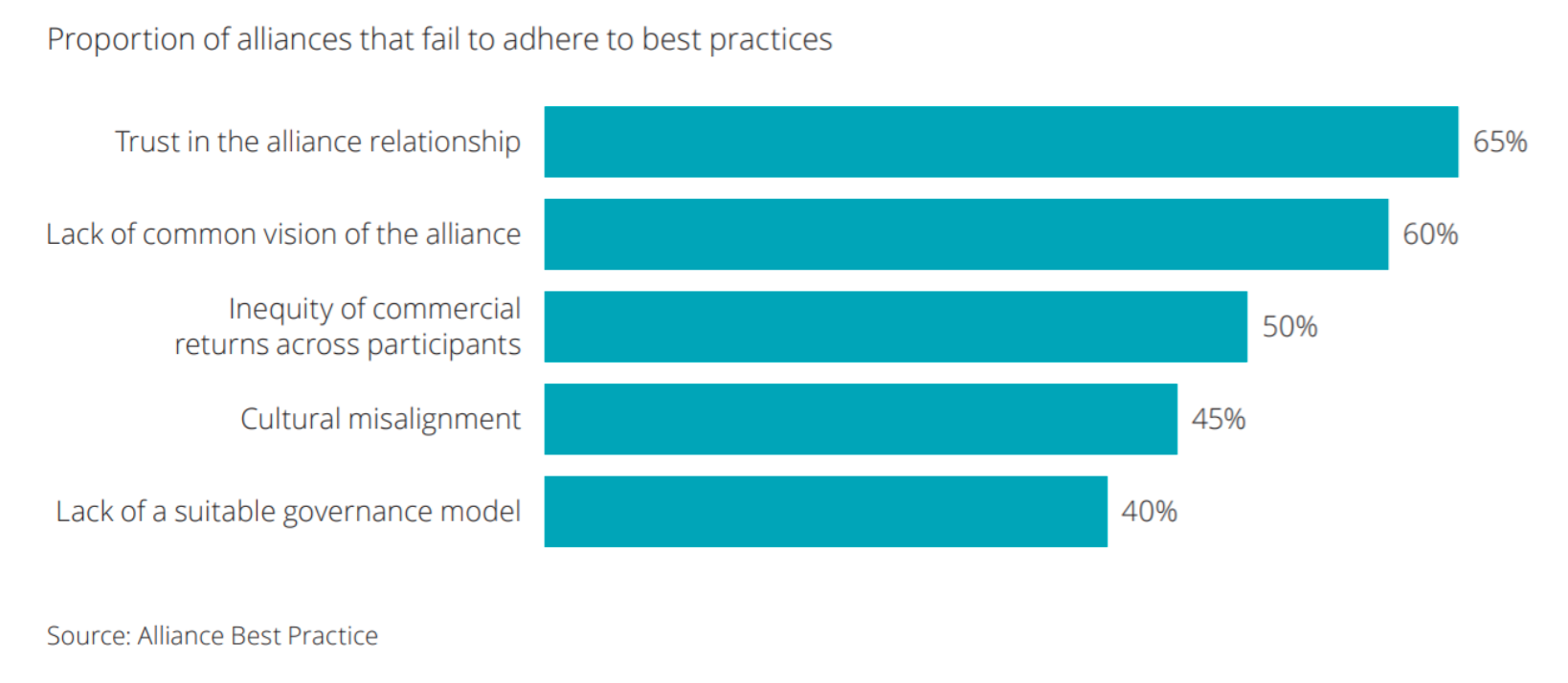 Strategic alliances are a vital tool to driving growth by enabling access to external capabilities. They are collaborations, partnerships, or joint ventures whereby organisations, or partners, work together for a common purpose to achieve a common business benefit or purpose.
Strategic alliances are a vital tool to driving growth by enabling access to external capabilities. They are collaborations, partnerships, or joint ventures whereby organisations, or partners, work together for a common purpose to achieve a common business benefit or purpose.
As much as strategic alliances are an important tool to drive growth and deliver needed capabilities, they are not without their challenges and risks.
More than a decade and a half of data from Alliance Best Practice, a UK-based research and benchmarking firm, show that 40 per cent of alliances fail to comprehensively address the commercial, strategic, operational, cultural, and technical leading practices that together contribute to the success of such efforts.
Benchmarking data on the most common ways in which alliances fail to embrace specific leading practices show persistent management shortfalls, as shown below:
Risk in collaborations are higher
Collaborations are inherently riskier than other activities undertaken by an organisation. This may be true because of each partner:
- Exercises little control, influence, or authority over the actions of other partners.
- May pursue different and sometimes conflicting intent, interests, and objectives.
- Does not know each other very well or may not have worked with each other in the past.
Most organisations are not designed for collaboration
Executives do not appreciate what collaboration truly entails. They assume that their existing processes, infrastructure, and management practices are suitable for collaboration with an external partner.
There are three critical mistakes in collaborative endeavours:
- Organisations do not consider the strategic role of collaborations.
- Organisations do not organise effectively for alliances, internally and externally.
- Organisations do not make long-term investments to develop collaborative and relationship capabilities and capacities.
The idea of shared risk is foreign to many
The idea of ‘sharing’ risks or working on common or systemic risks with other organisations, even in the context of collaboration, can be very unfamiliar territory for many executives.
Shared risks in collaboration are generally defined within the individual operations of each organisation. These risks were not ‘shared’ but ‘divided’ amongst partners in very specific ways – for example, in terms of the role, function, or service.
The risk management approaches and systems used by partners in collaborations have been based on business models that have failed to address shared, or systemic or whole of industry risks. They reinforce blame avoidance and risk shifting to weaker partners, thus reducing incentives for collaborative and integrated service provisioning.
Implementing shared risk management in collaborations
The relationship between partners is an important aspect regarding shared risk management that identifies and manages shared risks and inter-organisational risks.
Risk management must be performed by all partnering organisations continuously to achieve their strategic objectives and collaboration goals, all within acceptable levels of performance, risk, and tolerance. It can be performed jointly when risk affects two or more partners in the collaboration.
There are key points relating to shared risk management that are key ingredients in driving a successful collaboration outcome:
- There must be a formal governing body of the collaboration (e.g., joint governance committee) that provides the required and necessary governance structure, arrangements, and oversight over some of the following:
a. Clarity around the requirements, understanding, and expectations of the collaborative arrangement and achievement of collaboration’s joint or common goals.
b. Performance monitoring and reporting.
c. Prioritised collaboration activities and collaborative partnerships and relationships.
d. Development and implementation of shared risk treatment plans to mitigate shared risks.
e. Protocols in place and documentation in order with each partner committing dedicated persons and resources to take care of the external and internal relationship building and collaboration performance (or non-performance).
In that formal governing body, there will be a single accountable person who will be solely responsible for the delivery (or non-delivery) of the collaboration goal. The performance of the collaboration must rest solely on one person, rather than a committee with ‘faceless’ people.
- Individual partner’s organisational-level risk management framework must integrate and interoperate with:
a. The collaboration’s shared risk management framework where there is close linkage and relationship to each partner’s organisational-level risk management policy, plans, and processes.
b. All other partners’ organisational-level risk management frameworks on the assumption that there will be a certain level of maturity of each partner’s risk management framework and processes) for shared risk management to be effective.
Shared risks within collaborative pursuits can be actively managed when there is appropriate shared risk management in place. Shared risk management builds upon the organisational risk management practices where it manages shared risks.
(For more information about applying shared risk management, refer to Patrick’s ebook, How to Improve the Performance of Collaborations, Joint Ventures, and Strategic Alliances : The Shared Risk Management Handbook)
Professional bio
As a Chartered Accountant with over 25 years of international risk management and corporate governance experience in the private, not-for-profit, and public sectors, Patrick helps individuals and organizations make better decisions to achieve better results as a corporate and personal trainer and coach at Practicalrisktraining.com.
His “Practical ISO22301 Business Continuity Management That Works” Udemy course can be found here – https://bit.ly/3rOxmqm.
He is also the co-founder of Skillsand.org, an organisation dedicated to helping people acquire in-demand job skills and preparing them for the future of work. Our goal is to create a convenient learning experience that’s as easy as making any other purchase on Amazon.
Patrick has authored several eBooks including Strategic Risk Management Reimagined: How to Improve Performance and Strategy Execution.
.
